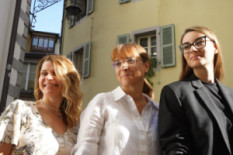What are the peculiarities of the education system in Switzerland?
In Switzerland, there is compulsory secondary education that 100% of the population must receive. It takes 11 years to complete. Children start school at the age of four or four and a half. By age 15-16, they have completed compulsory Swiss education.
The first stage of education is primary school, which includes two years of basic education (a kind of preschool) and six years of primary education.
Around 12, students are categorized into three groups based on exams and teacher evaluations, which largely determine their further educational path. Some enter the "university track," while others pursue vocational professions. I will explain this in more detail below.
Those who plan to enter higher education institutions need to go through an additional program. It is somewhat equivalent to our grades 10-12 and university preparatory courses. They study subjects that Ukrainian universities teach in the first and second years. After completing this program, they need to pass exams, based on which students can apply to various universities. As a result, Swiss students enter higher education institutions at around 19 years old and are already well-prepared.
As for Ukrainian teenagers who find themselves in Switzerland at the ages of 15-16 or 17, they not only do not undergo categorization but also have not received compulsory secondary education or have not completed the so-called "post-obligatory" education. Therefore, it is practically impossible for them to enter a state university. Ukrainian parents need to understand this. Moreover, state universities mainly teach in the cantonal language, and very few English-language programs have high competition.
Swiss authorities extend the learning period for Ukrainian students, but catching up with Swiss children and going through all the necessary stages in public schools is nearly impossible. In that case, one can try private schools, of which few are in Switzerland. They have smaller class sizes, intensive programs, and more attention from teachers, making bringing children up to the required level more realistic. Of course, this depends on the children's age and the parents' financial capacity. Swiss families also use the services of private schools to improve their children's results and help them enter universities.
Regarding the organization of the daily learning schedule, some aspects often surprise Ukrainian parents. One such aspect is a long break of two hours between learning blocks. During this break, parents must either pick up their child and bring them back or leave them in the extended day group for an additional fee.
After the break, children continue learning from the first or second half-hour until 4:00 PM. Parents must pick up their child again or pay for extended daycare after 4:00 PM.
Extended day care is available only for working parents. Non-working parents may be offered this option only if there are open spots. Mothers looking for work or attending courses can also leave their children in extended daycare. However, this service is always fee-based and not included in the basic educational services.
Another noteworthy point that will be useful for understanding the Swiss mentality is that children from different grades come to and leave school at different times to avoid congestion in front of schools and on the roads. It's a distinctly Swiss way of organizing and arranging things. Even the breaks between classes for children from different grades are scheduled at different times, allowing each child to play on the playground.
How is education organized in primary and elementary school?
During the first two years in kindergarten, children learn the basics, such as numbers and letters, and engage in various activities. This is similar to what Ukrainian preschools offer. There are many activities related to music and physical education. It's a combination of learning and play, which is natural because, at the age of up to six years, play is the leading activity. Interestingly, many Swiss children can already read at the age of three or four. It comes to them very organically.
Teachers do a lot to make children love school. However, at the same time, even at this stage, students are taught discipline. They come to school at specific times, have a daily routine, and get used to living according to the Swiss clock. Moreover, the older the child, the earlier they arrive at school. Initially, it's around 8:30 or 8:40 in the morning, and then it becomes 7:45.
From the age of 6, children attend elementary school for 6 years, where they acquire the core curriculum and learn to be disciplined and responsible. After that, they face exams, categorization, and transition to compulsory middle school.
What are the peculiarities of education in middle school?
Children enter middle school at around the age of 12. Teachers, based on clear criteria, categorize the students.
The first category includes the brightest students with no academic or behavioral issues. They can pursue university education and institutes in the future.
The second category consists of children with certain difficulties with grades and/or behavior. Parents can hire tutors for such children to improve their knowledge and discipline, which may allow them to move to the first category.
The third category, let's say, is the working class. They will not pursue higher education and may not continue studying after school. And that is perfectly normal because all professions are necessary and important in society. Some people must provide various services, work as cleaners, and perform many essential jobs. It is impossible to move from this level to the first category within the framework of the public school system. However, if desired, one can transfer to a private school and try to make up for the differences.
I want to emphasize that in addition to academic achievements, behavior is also taken into account. A brilliant child often ends up in the second category due to poor discipline. This is also important to understand the Swiss mentality and the peculiarities of the education system.
In middle school, students who are not successful may be held back for another year. Sometimes, half of the class may be held back. However, the opposite can also happen when talented children skip grades and finish school earlier if they wish to do so.
What happens after completing 11 years of compulsory education?
Several options depend on the child's level of preparation, interests, and the parents' possibilities.
As I mentioned before, for children planning to pursue higher education, there are mandatory programs to prepare for it, such as the Swiss Maturity program. It can be a state program lasting 3-4 years, or private programs, typically lasting 2 years. Graduates of state schools take exams in 12 subjects. I should note that these are very challenging programs and demanding exams, but their results open doors to various universities and broad educational opportunities. Private programs have fewer exams, usually six. After completing them, students can apply to specific universities, as they have the opportunity to choose only the subjects required for admission to their chosen fields.
After compulsory education, children can also pursue vocational education within schools or vocational training institutions. After vocational training, individuals can work in their field or continue their education either at higher vocational educational institutions or higher vocational schools.
The topic of higher education organization is quite complex and extensive, and we will discuss it in the next column.







